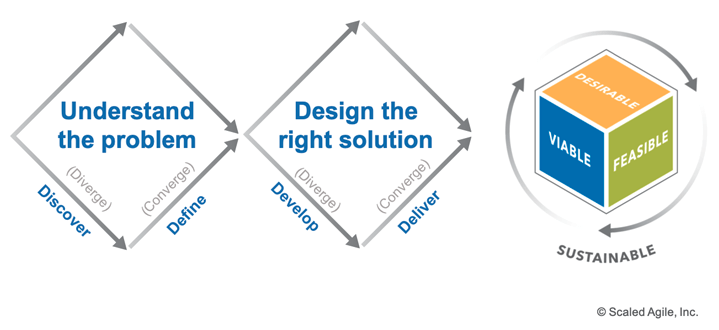How Design Thinking Powers Agile Product Delivery in SAFe 5.0
If you’ve been using the Scaled Agile Framework (SAFe) for a while now, the basics are pretty clear to you. And, while the recently released SAFe 5.0 is a significant update to the framework, most of those basics still apply.
But, there are also some truly transformative changes that have brought SAFe even more in line with how Agile needs to work in the real world in 2020. One of those changes is the infusion of the Design Thinking concept into all aspects of the workflow. Another is the focus on Agile Product Delivery as one of the seven core competencies that provide the foundation of the new SAFe.
If you’re not familiar either or both of those concepts, we recommend starting with the primers provided by the SAFe team themselves:
What we’re going to discuss here, though, is where and how they intersect in the modern development organization. And, we’ll look at some practical recommendations for integrating them into your own agile practices, whether or not you’re up to speed on the full SAFe framework.
Why Focus on Design Thinking?
Per SAFe: “Design Thinking is a customer-centric development process (that)… emphasizes understanding the problem to be solved, the context in which the solution will be used, and the evolution of that solution.”
In other words, Design Thinking is a loose process that can be applied to various disciplines, rather than a strict set of rules or checklist to follow. As such, it’s not limited to just the planning stage, just the discovery stage, or just the development stage. In all these stages and more, it’s going to keep activities revolving around three key matters:
- Understanding the problem from the customer’s point of view
- Designing the right solution, which depends to a large extent on technical feasibility
- Ensuring the solution is viable and sustainable from a financial standpoint
Design Thinking is going to have an influence on how epics, features, and stories are conceived. It’s going to inform which stories and features bubble to the top in both planning and deployment phases. And, it’s going to serve as a filter to guide how we collect, analyze, and synthesize feedback from each release — another important SAFe concept called continuous product learning.
What Does Design Thinking Have to do With Agile Product Delivery?
Again, per SAFe: “Agile Product Delivery is a customer-centric approach to defining, building, and releasing a continuous flow of valuable products and services to customers and users.”
So, Agile Product Delivery is more of a mindset or approach to the work, rather than a quantifiable process. It involves keeping the customer front and center throughout the entire product lifecycle, and making sure the workflow doesn’t devolve into an archaic “project” that requires “management”.
It also involves developing on cadence — a concept that most Agile development organizations already have down — but releasing on demand. It’s the “on demand” part that still stymies many teams who have grown comfortable with Scrum-style iterations, where each sprint ends with a “useful” release at the end. Instead, Agile Product Delivery embraces continuous delivery at whatever cadence / timeline / release schedule is best for fulfilling the customer’s unique needs and desires.
DevOps and the Continuous Delivery Pipeline round out the Agile Product Delivery package by having the technological and logistical foundation in place to support continuous, on demand delivery.
Design Thinking is an integral part of Agile Product Delivery because it’s a reliable, repeatable method that keeps the product centered around the customer while also ensuring a solution is feasible, economically viable, and sustainable throughout its lifecycle. It transcends specific teams or disciplines, so it serves as the steel thread that runs through the entire Agile Product Delivery process.
So, What Does Agile Product Delivery — Powered by Design Thinking — Look Like in the Real World?
Almost all companies start out focused on the customer and innovation. They’re out to disrupt their industry and solve real problems for real people. But over time, as that company grows and succeeds, a traditional hierarchy of managers and support staff grows to provide stability and efficiency. It’s inevitable and necessary if the company is going to continue to grow. Unfortunately, the hierarchy tends to eventually overwhelm the original customer-focused, disruptive, entrepreneurial network. As a result, the speed of innovation slows.
As we all know, that’s a death knell for the modern organization. No matter how big or successful a company is, the moment it slows down, a thousand other companies are right there to swoop in and woo the customer away. Businesses that can’t pivot and innovate fast enough risk a slow and agonizing death.
That was the whole reason behind Agile software development in the first place, and the environment has only grown faster and more complex since it first arrived on the scene. Today, simply breaking your work into two-week intervals and having a daily standup isn’t going to yield the same results as it once did.
Instead, the modern organization needs to be Agile at the core.
Lean and Agile principles need to be so deeply embedded in its activity, it permeates every level of hierarchy and every business unit. That’s what the newest iteration of the Scaled Agile Framework makes possible: true business agility. And, Agile Product Delivery, powered by Design Thinking, is a vital aspect of the framework.
If you’d like to hear Dean Leffingwell, the creator of SAFe, and Anne Steiner, Cprime’s VP of Product Agility, discuss this subject in even greater detail, listen to our free webinar, “Real Life Agile Product Delivery, Using Design Thinking, in SAFe 5.0”. If you’re ready to put SAFe 5.0 into practice in your own organization, we can help with that.



